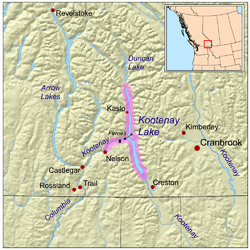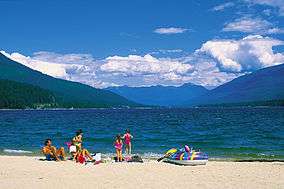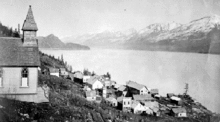Kootenay Lake
| Kootenay Lake[1] | |
|---|---|
 Map of Kootenay Lake, British Columbia | |
| Location | Kootenay region, British Columbia |
| Coordinates | 49°38′N 116°55′W / 49.633°N 116.917°WCoordinates: 49°38′N 116°55′W / 49.633°N 116.917°W |
| Primary inflows | Kootenay River |
| Primary outflows | Kootenay River |
| Basin countries | Canada |
| Max. length | 104 km (65 mi) |
| Max. width | 5 km (3.1 mi) |
| Average depth | west arm 10 m (33 ft), main lake 45 m (148 ft) |
| Max. depth | 150 m (490 ft) |
| Residence time | avg. 1.5 years |
| Surface elevation | 532 m (1,745 ft) |
| Settlements | Nelson, British Columbia |
Kootenay Lake is a lake located in British Columbia, Canada and is part of the Kootenay River. The lake has been raised by the Corra Linn Dam and has a dike system at the southern end, which, along with industry in the 1950s-70s, has changed the ecosystem in and around the water. Kootenay Lake has a year-round toll-free ferry that crosses between Kootenay Bay and Balfour, and is a popular summer tourist destination.[2]
Geography
Kootenay Lake is a long, narrow and deep fjord-like lake located between the Selkirk and Purcell mountain ranges in the Kootenay region of British Columbia.[3][4] It is one of the largest lakes in British Columbia, at 104 km in length and 3–5 km in width.[1] It is, in part, a widening of the Kootenay River, which in turn drains into the Columbia River system at Castlegar, British Columbia.[1]
Although oriented primarily in a north-south configuration, a western arm positioned roughly halfway up the length of the lake stretches 35 km to the City of Nelson.[5] The lake is 532m above sea level,[1] with the adjacent mountains rising up to a maximum of approximately 2700m.[3] The average residence for water in the lake is 1.5 years, although the west arm has a much faster rate of water replacement; about 3–4 days.[3]

Kootenay Lake was formed through river erosion and, later, glaciation. The erosion began during the late Cretaceous until ice filled the resulting valley in the Pleistocene.[4] When the valley was filled with ice, glaciers from the mountains (the Selkirks and Purcells) fed the valley's ice mass. The glacier that occupied what is now the west arm of Kootenay Lake flowed into the Kootenay ice mass. As the ice melted from this glacier, drainage flowed over an area near what is now Nelson, causing the west arm of the lake to drain toward the west. A large moraine formed near what is now the large bend in the Kootenay River near Libby, Montana. As ice melted, a lake formed behind the moraine and drained southward over top of it. The southerly drainage over the moraine eventually stopped and the Kootenay River began to follow its present course.[4]
History
Kootenay Lake is part of the traditional territory of the Sinixt and Ktunaxa peoples.[6] These native populations used the lake and associated river systems as part of their seasonal migration and trading routes.[4]
In 1958 the Kootenay Lake Crossing, an electrical power line, was built, running across the north arm of Kootenay Lake. It was destroyed in 1962 by protestors and rebuilt later that year.[7]
The lake originally seasonally flooded an approximately 80 km long marsh lying to the lake's south within the Creston Valley. However, this has now been diked and converted to commercial agriculture. A smaller wetland area has been protected in this area.
In 1931, Corra Linn Dam was built at the outflow from Kootenay Lake, where it once again became a river.[8] The dam provides flood control and winter power generation by raising the normal water level by two meters. Just down river is Bonnington Falls, today the site of several hydroelectric dams. In 2003 the lake discharged 16.9 billion cubic metres of water. High water for that year was a normal 533 metres, the record is 537 metres in 1961.[9] In 1967 as part of the Columbia River Treaty the Duncan Dam was constructed above Kootenay Lake on the Duncan River, creating a 7,145 hectare reservoir for flow control.[10] Also part of the treaty Libby Dam in Montana, was completed in 1975.
Fauna
There are seven species of fish in Kootenay Lake: Rainbow trout (Walbaum 1792), Bull Trout, Burbot, Mountain Whitefish, White Sturgeon, Brook Trout, Largemouth Bass, Yellow Perch and Kokanee Salmon.[4]
There was a large decrease in the numbers of Kokanee in the west arm of the lake in the late 1970s. The salmon fishery was closed in 1980 and remains closed as of 2011. The reason for the decline is not known; possibilities include reduced numbers of Mysis relicta (which had been introduced as a food source for the Kokanee in 1949)[10][11] into the west arm due to the increased control of water levels, the disruption of rearing habitat due to recurring drawdown of the lake, reduced productivity of benthos due to the reduction of the amount of nutrients into the lake (after the close of the fertilizer plant), overfishing in the 1960s to 1970s[4] or competition between the Mysis relicta and immature fish.[11] In 1990 the lake's southern Kokanee stocks neared extinction, and an experimental fertilizing program was started, with some success.[1][10]
Human use and impact
Settlements

Approximately 19,700 people live within 2.5 km of the Kootenay Lake shore; about 14,300 of those live in the City of Nelson.[3] The remaining are scattered among a number of small towns and villages:
- Boswell, British Columbia
- Crawford Bay, British Columbia
- Ainsworth, British Columbia
- Kaslo, British Columbia
- Riondel, British Columbia
- Balfour, British Columbia
- Grey Creek, British Columbia
- Kootenay Bay, British Columbia
- Harrop, British Columbia
- Procter, British Columbia
- Sirdar, British Columbia
Pollution
Water quality in the lake was negatively affected when the Cominco phosphate fertilizer plant on the Kootenay River at Kimberley opened in 1953.[10] Large quantities of phosphorus entered the Kootenay River; the cause of cyanobacterial blooms from the 1950s until the early 1970s. Attempts to limit pollution, the closure of the plant (in 1973),[10] and construction of the Libby Dam on the Kootenai River in Montana combined to reduce phosphorus levels in the lake from the recorded highs.[4]
Ferry

The lake is crossed by the Kootenay Lake Ferry, a toll-free vehicular ferry operating between Balfour and Kootenay Bay. The ferry operates two boats in the summer and one during the winter.[12]
See also
Steamboats
References
- 1 2 3 4 5 "Balance of Power, Hydroelectric Development in Southeastern BC, Kootenay Lake". Virtual Museum. Retrieved February 15, 2011.
- ↑ "International Lake Environment Committee, Promoting Sustainable Management of the World's Lakes and Reservoirs, KOOTENAY LAKE, February 15, 2011". Wldb.ilec.or.jp. Retrieved 2013-05-02.
- 1 2 3 4 Kootenay Lake, Retrieved February 15, 2011
- 1 2 3 4 5 6 7 International Lake Environment Committee, Promoting Sustainable Management of the World's Lakes and Reservoirs, KOOTENAY LAKE, Retrieved February 15, 2011.
- ↑ "Kootenay Lake, British Columbia, Canada". Britishcolumbia.com. Retrieved 2013-05-02.
- ↑ "Vancouver Island, Kootenay Lake, Kootenays, BC, Retrieved February 15, 2011". Vancouverisland.com. Retrieved 2013-05-02.
- ↑ Fortis BC, Retrieved February 15, 2011. Archived December 24, 2010, at the Wayback Machine.
- ↑ BC geographical names, Corra Linn Dam, Retrieved February 15, 2011.
- ↑ http://www.ijc.org/rel/boards/Kootenay_Lake/klbc_2003_annual_report.pdf
- 1 2 3 4 5 Fish and Wildlife Compensation Program, Background and History, Retrieved February 15, 2011.
- 1 2 Fly Fish BC, Kootenay Lake Karma, Retrieved February 15, 2011.
- ↑ "Ministry of Transportation Inland Ferry Schedules, Kootenay Lake Ferry, Retrieved February 15, 2011". Th.gov.bc.ca. 2013-04-23. Retrieved 2013-05-02.
External links
| Wikimedia Commons has media related to Kootenay Lake. |